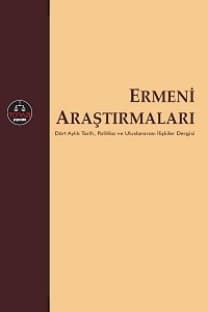İmparator Herakleios Döneminde Bizans'ın Doğu Politikası ve Armenia
7. yüzyılın başı Bizans tarihi açısından tam bir kaos dönemidir. Sâsânîlerin Khalkedon önlerine kadar gelmeleri ve başkenti tehdit etmeleri Bizans’ın tarihinde önemli bir olaydır. Herakleios emperyal erki ele alınca uzun bir zaman neler yapması gerektiğini planlamış ve Batı yönünde de büyük bir tehlike olmasına rağmen politikasını Doğu yönünde belirlemiştir. Bu politikanın da ana hedefleri içinde Ermeniler önemli bir rol oynamışlardır. Herakleios’un düşündüğü yeni sistem için Ermeniler başat oyunculardır ve onlar rollerini gerektiği şekilde oynamışlardır. Herakleios Sâsânîleri dizginledi, lakin hiç beklemediği yeni bir oyuncu tarih sahnesine çıkmıştır. Bu oyuncular Müslüman Araplardı ve Batı’nın Pers algısının yerini alacaklardır. Bu durumdan Bizans kadar Ermeniler de etkilenecektir.
Anahtar Kelimeler:
Herakleios, Sâsânîler, Müslüman Araplar, Ermeniler
The beginning of the 7th century was a period of complete chaos in Byzantine history. The arrival of the Sassanids in front of Chalcedon and threatening the capital are critical events in Byzantine history. When Heraclius took imperial power, he planned what he should do for a long time, and determined his policy in the East, although there was a great danger in the West. Armenians played a crucial role in the main
objectives of this policy. Armenians were the main actors in the new system that Heraclius envisioned, and they played their roles properly. Heraclius restrained the Sassanids, but a new player, whom he never expected, appeared on the stage of history. These players were Muslim Arabs and would replace the Western perception of Persia. Armenians would be affected by this situation as much as Byzantium.
___
- Artamonov Mihail Illarionoviç, Hazar Tarihi, b.5, çev: Ahsen Batur, İstanbul: Selenge, 2019.
- Chronicon Paschale 284-628 AD, ing çev: Michael Whitby, Mary Whitby, Liverpool: LUP, 2007.
- Cheikh Nadia Maria, Arapların Gözüyle Bizans, çev: Mehmet Moralı, İstanbul: Alfa, 2012.
- Diehl Charles, L’afrique Byzantine de la Domination Byzantine en Afrique (533-709), Paris: Ernest Leroux, 1896.
- Dunlop Douglas Morton, Hazar Yahudi Tarihi, b.2, çev: Zahide Ay, İstanbul: Selenge, 2016.
- Garthwaite Gene, The Persians, Blackwell, 2005.
- Grousset, René, Histoire de l’Arménie des originas à 1071, Paris: Payot, 1973.
- Gürcistan Tarihi, çev: Hrant D. Andreasyan, Ankara: TTK, 2003.
- Haldon John, “The Reign of Heraclius – A Context for Change?” The Reign of Heraclius (610-641) Crisis and Confrontation, ed: Gerrit J. Reinink, Bernard H. Stolte, Peeters, 2002.
- Halîfe B. Hayyât, et-Târîh, çev: Ömer Sabuncu, Mahmut Sabuncu, Ankara: Ankara Okulu, 2019.
- İbn A’sem, el-Fütûh, c.I, çev: Mehmet Cevher Caduk, Ankara: Ankara Okulu, 2020.
- İbn Cerîr et-Taberî, Tarihu’t-Taberî, c.III, çev: Cemalettin Saylık, Ankara: Ankara Okulu, 2019.
- İbn Ebî Şeybe, Kitâbü’l-Megâzî, çev: Ramazan Önal, Ahmet Şen, Ankara: Ankara Okulu, 2019.
- Kaegi Walter, Byzantium and the Early Islamic Conquests, Cambridge: CUP, 2005.
- Kaegi Walter, Heraclius Emperor of Byzantium, Cambridge: CUP, 2003.
- Kalankatlı Moses, Alban Tarihi, çev: Yusuf Gedikli, İstanbul: Selenge, 2006.
- Khazdan Alexander, The Oxford Dictionary of Byzantium, c.II-III, New York: OUP, 1991.
- Kirakos Gandzakets’i’s History of the Armenians, çev: Robert Bedrosian, New York, 1986.
- Maksymiuk Katarzyna Iwona, “Destruction of the ādur gušnasp temple in ādurbādagān as a revenge for abduction of the Holy Cross from Jerusalem in the context of the letters of Heraclius,” ИСМОРИЯ ДРЕВНЕГО МИРА (Istoriya Drevnego Mira), Udc 94 (357).
- Maurikios’a atfedilen bu strategikon kitabı için bkz: Mauricce’s Strategikon: Handbook of Byzantine Military Strategy, çev: George T. Dennis, Philadelphia: UPP, 1984; Türkçe çev; Strategikon – Bizans Kültüründe Strateji Sanatı, çev: Volkan Atmaca, İstanbul: Kırmızıkedi, 2010.
- Mitchell Stephen, A History of the Later Roman Empire AD 284-641, b.2, Blackwell, 2015.
- Nicephori Patriarchae Constantinopolitani, Breviarium Historicum, ed-çev: Cyril Mango, Washington: Dumbarton Oaks, 1990.
- Norwich John Julius, Bizans – Erken Dönem (MS 323-802), çev: Hamide Koyukan, İstanbul: Kabalcı, 2013.
- Ostrogorsky, Bizans Devleti Tarihi, b.7, çev: Fikret Işıltan, Ankara: TTK, 2011.
- Öztürk Engin, Bizans Döneminde Anadolu’da Yaşayan Ermeniler, İstanbul: Urzeni, 2020.
- Pourshariati Parvaneh, Decline and Fall of Sâsânian Empire, London: I.B. Tauris, 2008.
- The Armenia History attributed to Sebeos, çev: R.W. Thomson, Liverpool: LUP, 1999.
- The Chronicle of John, Bishop of Nikiu, çev: R.H. Charles, London: Williams&Norgate, 1916.
- The Chronicle of Zuqnin (Parts III and IV. A.D. 488-775), çev: Amir Harrak, Canada: PIMS, 1999.
- The History of the Theophtlact Simocatta, çev: Micheal Whitby, Mary Whitby, Oxford: Clarendon, 1997.
- Theophanis, Chronographia, ed: Carolous de Boor, Lipsiae, 1883.
- Timothy Venning, A Chronology of the Byzantine Empire, New York: Palgrave, 2006.
- Treadgold, A History of the Byzance State and Society, California: SUP, 1997.
- Umar Bilge, Türkiye’deki Tarihsel Adlar, İstanbul: İnkılâp, 1993.
- Vasiliev Alexander, Bizans İmparatorluğu Tarihi, çev: Tevabil Alkaç, İstanbul: Alfa, 2016.
- ISSN: 1303-068X
- Yayın Aralığı: Yılda 2 Sayı
- Başlangıç: 2001
- Yayıncı: Avrasya İncelemeleri Merkezi
Sayıdaki Diğer Makaleler
İkinci Karabağ Savaşı’ndaki Türkiye-Azerbaycan İttifakının Rol Teorisi Çerçevesinde Analizi
RUSYA’DAKİ ERMENİ NÜFUSUNUN TARİHSEL GEÇMİŞİ VE ERMENİLERİN DEMOGRAFİK YAPISI (1926-2010)
İmparator Herakleios Döneminde Bizans'ın Doğu Politikası ve Armenia
JAPONYA’DAN BİR MEKTUP STRATEJİK SUSKUNLUK: ERMENİLERİN SESSİZLİĞİ
